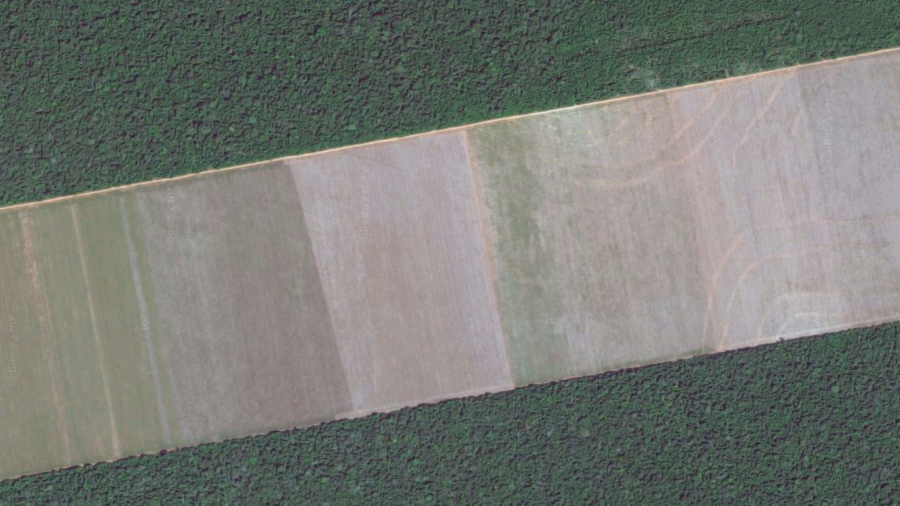“Efficiency” usually means the degree to which costly inputs to a process are reduced in relation to the process’s desirable outputs. This linear input-process-output model of efficiency fits well with the linear models of production, consumption, and growth that have been spreading, like cultural parasites, over the globe for the past few hundred years.
On a finite planet, though, such linear models are doomed.
Is there a measure of efficiency that could work on a finite planet? One that could guide us toward cyclic, harmonious processes rather than linear, doomed processes?
A Tale of Two Hamburgers
In the Mato Grosso province of Brazil, near the Xingu River, on the traditional lands of the Bororo indians, in the midst of one of the most biodiverse ecosystems on the planet, is a 32,123-acre soybean plantation. Its borders are sliced out of the green patchwork of forest with satellite-guided precision in a perfect rectangle. Planted and fertilized by tractors, dusted and sprayed by airplanes, harvested by a swarm of massive combines, this is, in conventional terms, possibly one of the most efficient food production operations in the history of human civilization.

In ecological terms, though, it is a monster of staggering proportions. This monster stretches back and forward in time: back through the network of energy and chemicals that feeds the soy plantation, and forward into the places where the soybeans and the leftovers from their production will go.
These soybeans grow on fossil fuels, from Venezuela or Saudi Arabia or Kazakhstan, refined and shipped across oceans and burned to make the concentrated nitrogen fertilizer needed to grow soybeans in the thin post-rainforest soil. Some of this nitrogen becomes soybeans, while much of it floats into the atmosphere as nitrous oxide, a highly potent greenhouse gas, or runs off into rivers and eventually estuaries. The soybeans are transported to feedlots where they are fed to fattening cattle. Some of this nitrogen becomes manure and urine, and the rest becomes beef. The beef eventually comes to North American fast-food restaurants, and is turned into hamburgers. The hamburgers are enclosed in disposable packaging, money is exchanged, the hamburger is eaten, and the packaging is thrown away.
This is not the end of the hamburger. Once eaten and digested, the nitrogen whose journey through the linear food system began with fossil fuel extraction goes from a gut to a toilet to a sewage plant, and eventually ends its journey by being dumped into a river or an ocean or denitrified into the atmosphere as nitrous oxide.
This hamburger — we’ll call it Hamburger A — is a masterpiece of linear efficiency. Every step in its production and disposal may be fully optimized for maximally efficient use of human labour, capital, and even energy. The business plan of hamburger A is optimized to perfection. But, because every part and process of hamburger A begins somewhere and ends somewhere else, and the two do not connect, there is a vast impact that is outside the business plan of the hamburger, but borne by the Earth. Hamburger A is a linear hamburger of doom.
Now consider Hamburger B. It is a hamburger that could, in an only slightly different version of reality, be purchased at the food co-op on the small island where I live. It is almost a Möbius hamburger, because there’s no beginning and no end to any of its parts, but we have to start somewhere: nitrogen-rich manure from animals and humans is applied to nearby grass and grain fields. Cows eat the grass, while fertilizing it with their excrement. Grain is harvested using human and animal labour and small machines, then ground into flour nearby. Cows are butchered, and ground up in small batches. Farm and processing leftovers are recycled through composting and carbon-sequestering biofuel cycling. Flour and meat are transported a short distance, then made into a hamburger and immediately eaten, without packaging. Once it’s served its purpose in the human digestive tract, hamburger B is composted and recycled into fertilizer.
In conventional terms, hamburger B is appallingly inefficient. The localization of production and processing eliminates all the economies of scale that benefit mass production. Every step in the process is small, slow, and labour-intensive. Marketing, branding, testing, process design, and transportation all have to be figured out locally, rather than by specialists in a centralized organization.
But, in ecological terms, hamburger B is far more efficient than hamburger A, because the required adaptation of nature is minimal — it doesn’t create extractive impacts from mining fossil fuels or mineral fertilizers, and it has only very small, local impacts from the leftovers of the system’s processes. We could call this property of Hamburger B, the minimal adaptation required by the rest of nature, ecological efficiency. Under this definition, a process is ecologically efficient in inverse proportion to the amount of adaptation — present or future — that it demands in the surround bio-ecosystem.
Hamburger B is ecologically efficient, but where does that get us? In our current economic arrangement, almost nowhere.
The Economic Catastrophe
It is well known that hamburger A is a disaster, and hamburger B is where we need to be heading. Why, then, is hamburger A still taking over the world, and hamburger B still disappearing?
We can think of a socioeconomic system as a Darwinian environment that shapes the fate of its contents, in the same way that rocky environments lead to the evolution of mountain goats and the deep ocean vent environments lead to sulfur-breathing tube worms. I call this extension of the notion of selection from evolutionary theory the principle of selective systems. In an economic environment where conventional efficiency is the sole determinant of fitness, hamburger A out-competes hamburger B. This is why, in North America, hamburger B has become scarcer and scarcer, and hamburger A more and more ubiquitous, even though A is, in systemic terms, a defective hamburger that carries the seeds of its own destruction.
In biology, something like this has been dubbed a trojan gene effect: a heritable trait may confer some extra virulence and spread through a population, even though it weakens the population overall, potentially leading to its collapse. In this case, the unchecked spread of hamburger A and all that goes with it, driven by a relentless maximization of conventional efficiency, could lead to the conclusion of our current attempt at civilization and the end of the hamburger as we know it.
Conventional efficiency is driving the biosphere to the edge because to be inefficient is expensive. Our economic system is designed around the maximization of linear, economic efficiency, not ecological efficiency. There is zero economic cost for ecological inefficiency, except where it overlaps with conventional efficiency because of resource costs or where government regulation has made pollution or extraction expensive.
We all know that hamburger B is better, but still, hamburger A wins.
Hope, or something like it
Looked at in strictly political, or economic, or ecological terms, it seems that we and the rest of life on this molten, igneous, fascinating, miraculously evolving megalith are, to put it bluntly, screwed. Neither market forces, nor altruistic politicians, nor ecologically conscious consumers have come anywhere close to turning our society from its dogged march towards ecological disaster.
If we zoom out from politics and economics and ecology to look at the larger picture, the situation looks even worse. This, paradoxically, might be reason for hope. Altruism may not have to work entirely on its own.
The same linear mindset that is wreaking havoc with the biosphere is at work in human society. For example, consider the linearity of current methods of handling a person’s passage through life. In traditional societies, the elderly generally take care of the young, while those of in between years are working. Today, this cyclical arrangement is broken: children start in a hospital, are then handled by a daycare, then go to school, then, if economic and social conditions permit, to university, then they get a job, possibly have children, eventually retire, and then are exported to a nursing home to end their days surrounded by other old people under the management of professional caregivers. This is an efficient system indeed: hospitals have specialized economies of scale at baby production, daycares have economies of scale managing herds of toddlers, schools are efficient at mass production of more or less socialized teenagers, filtered by obedience and academic skills, universities continue the filtration process and allow mass selection of mates, jobs fill most of the time not occupied by sports and television, and nursing homes keep the embarrassing and unsightly denouement of the human condition from distracting the workforce.
The psychological costs of this arrangement are on a par with the ecological costs of the linear industrial food/waste system. The Earth, which bears the burden of the latter, cannot speak. The humans, who bear the burden of the former, can speak, and are very gradually coming to grips with how thoroughly their lives have been misdirected through the machinery of linear efficiency and an economic dogma that deifies the crude satisfaction of material desires while blindly ignoring the ultimate purpose that satisfaction is supposed to serve: human well being.
This is, possibly, the most hopeful thing in the world.

